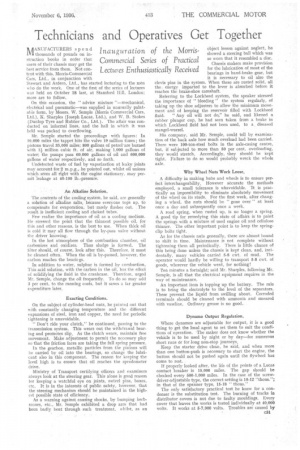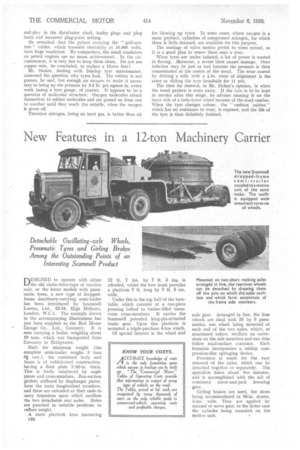Technicians and Operatives Get Together
Page 69

Page 70

If you've noticed an error in this article please click here to report it so we can fix it.
4ANUFACTURERS spend IVI thousands of pounds on instruction books in order that users of their chassis may get the best service from them. Not content with with this, Morris-Commercial Cars, Ltd., in conjunction with Stewart and Ardern, Ltd., has started lecturing to the men who do the work. One of the first of the series of lectures was held on October 28 last, at Stamford Hill, London; more are to follow.
On this occasion, the "advice mixture "—mechanical, electrical and pneumatic—was supplied in unusually palatable form, by Messrs. W. Semple (Morris Commercial Cars, Ltd.), K. Sharpies (Joseph Lucas, Ltd.), and W. B. Stokes (Dunlop Tyre and Rubber Co., Ltd.). The affair was conducted on informal lines, and the hall in which it was held was packed to overflowing.
Mr. Semple started the proceedings with figures : In 10,000 miles the tappet hits the valve 19 million times; the pistons travel 35,000 miles; 800 gallons of petrol-are burned with lj million cubic ft. of air, making 1,000 gallons of water; the pumps pass 60,000 gallons of oil and 600,000 gallons of water respectively, and so forth.
Undetected waste of fuel by vaporization at leaky joints may account for 2 m.p.g., he pointed out, whilst oil unions which seem all right with the engine stationary, may permit leakage at 40-100 lb.-pressure.
• , An Alkaline Solution.
The contents of the cooling system, he said, are generally a solution of alkaline salts, because everyone tops up, to compensate for evaporation, but rarely flushes out. The result is inefficient cooling and choked tubes.
Few realize the importance of oil as a cooling medium. He stressed the point that the thinnest possible oil, for this and other reasons, is the best to use. When thick oil is cold it may all flow through the by-pass valve without the driver knowing.
In the hot atmosphere of the combustion chamber, oil carbonizes and oxidizes. Thus sludge is formed. The filter should, of course, look after this. Therefore, it must be cleaned often. When the oil is by-passed, however, the carbon reaches the bearirgs.
In addition to water, sulphur is formed by combustion. This acid solution, with the carbon in the oil, has the effect of solidifying the fluid in the crankcase. Therefore, urged Mr. Semple, change the oil frequently. To do so may add 3 per cent. to the running costs, but it saves a far greater expenditure later.
• Exacting Conditions.
On the subject of cylinder-head nuts, he pointed out that with constantly changing temperature and the different expansions of steel, iron and copper, the need for periodic tightening is unavoidable.
" Don't ride your clutch," he continued, passing to the transmission system. This wears out the withdrawal bearing and promotes slip. As the clutch wears, maintain free movement. Make adjustment to permit the necessary play so that the friction faces are taking the full spring pressure.
In the gearbox, metallic particles from the pinions will be carried by oil into the bearings, so change the lubricant also in this component. The reason for keeping the level high is to ensure that oil reaches the speedometer drive.
Ministry of Transport certifying officers and examiners always look at the steering gear. This alone is good reason for keeping a watchful eye on joints, swivel pins, boxes, etc. It is in the interests of public safety, however, that the steering mechanism should be maintained in the highest possible state of efficiency.
As a warning against causing shocks, by bumping kerbstones, etc., Mr. Semple exhibited a drop arm that had been badly bent through such treatment, whilst, as an object lesson against neglect, he showed a steering ball which was so worn that it resembled a disc.
Chassis makers make provision for the lubrication of most of the bearings in hand-brake gear, but it is necessary to oil also the devis pins in the system. When these are rusted solid, all the. energy imparted to the lever is absorbed before it reaches the brake-shoe camshaft.
Referring to the Lockheed system, the speaker stressed the importance of " bleeding " the system regularly, of taking up the shoe adjusters to allow the minimum movement and of keeping the reservoir filled with Lockheed fluid. "Any oil will not do," he said, and likened a rubber plunger cup, he had seen taken from a brake in which Lockheed fluid had not been used, to a diseased mangel-wurzel.
His company, said Mr. Semple, could tell by examination of the back axle how much overload had been carried. There were 100-ton-steel bolts in the axle-casing centre, but, if subjected to more than 50 per cent. overloading, they would stretch. Accordingly, they should be kept tight. Failure to do so would probably wreck the whole axle.
Why Wheel Nuts Work Loose.
A difficulty in making hubs and wheels is to ensure perfect interchangeability. However ateurate the methods employed, a small tolerance is unavoidable. It is practically an impossibility to eliminate absolutely movement of the wheel on its studs. For the first week, after changing a wheel, the nuts should be gone over " at least once a day and subsequently once a week.
A road spring, when rusted up, is no longer a spring. A good tip for remedying this state of affairs is to paint the springs with a mixture of used engine oil and cellulose thinner. The other important point is to keep the springclip bolts tight.
As for the chassis nuts generally, these are almost bound to shift in time. Maintenance is not complete without tightening them all periodically. There is little chance of this being done unless the chassis is kept clean, and, incidentally, many vehicles carried 5-8 cwt. of mud. The operator would hardly be willing to transport 5-8 cwt. of goods, wherever the vehicle went, for nothing!
Ten minutes a fortnight; said Mr. Sharpies, following Mr. Semple, is all that the electrical equipment requires in tha way of maintenance.
An important item is topping up the battery. The rule is to bring the electrolyte to the level of the separators. These prevent the liquid from swilling about. Corroded terminals should be cleaned with ammonia and smeared with vaseline. Ordinary grease is no good.
Dynamo Output Regulation.
Where dynamos are adjustable for output, it is a good thing to get the local agent to set them to suit the conditions of operation. The maker does not know whether the vehicle is to be used by night or by day—for numerous short runs Or for long non-stop journeys.
Keep the starter drive clean, he said, and when more than one button-push is necessary to start the engine, the button should not be pushed again until the flywheel has come to rest.
If properly looked after, the life of the points of a Lucas contact breaker is 15,000 miles, The gap should be checked every 500-1,000 miles. In the case of the screwdriver-adjustable type, the correct setting is 10-12 "thous."; in that of the spanner type, 15-18 " thous."
The only satisfactory practical test he knew for a condenser is the substitution test. The burning of tracks in distributor covers is not due to faulty mouldings. Every cover that leaves the works is tested individually at 40,000 volts. It works at 5-7,000 volts. Troubles are caused by end-play in the distributor shaft, faulty plugs and plug leads and incorrect plug-point setting.
He remarked that the pylons carrying the " grid-system " cables, which transmit electricity at 10,000 volts, have huge insulators. By comparison, the small insulators on petrol engines are no mean achievement. In the circumstances, it is only fair to keep them clean. Do not use copper wire, he concluded, to replace a blown fuse Mr. Stokes, dealing with Dunlop tyre maintenance, answered the question why tyres leak. The rubber is not porous, he said, but enough air escapes to make it necessary to bring up the pressure by 3-5 lb. per square in. every week (using a tyre gauge, of course). It appears to be question of molecular structure. Oxygen molecules attach themselves to rubber molecules and are passed on from one to another until they reach the outside, when the oxygen is given off.
Therefore nitrogen, being an inert gas, is better than air for blowing up tyres. In some cases, where oxygen is a main product, cylinders of compressed nitrogen, for which there is little demand, are available for this purpose.
The seatings of valve insides perish to some extent, so it is a good plan to renew these once a year.
When tyres are under inflated, a lot of power is wasted in flexing. Moreover, a severe blast, causes damage. Over inflation may be just as bad because the pressure is then concentrated at the centre of the tread. The wear caused by driving a mile with a On. error of alignment is the same as sliding the tyre broadside for 11 yds.
The time for renewal, in Mr. Stokes's opinion, is when the tread pattern is worn away. If the tyre is to be kept in service after this stage, he advises running it on the inner side of a twin-tyred wheel because of the road camber. When the tyre changes colour, the " cushion rubber," which has no resistance to wear, is exposed, and the life of the tyre is then definitely finished.












































































































